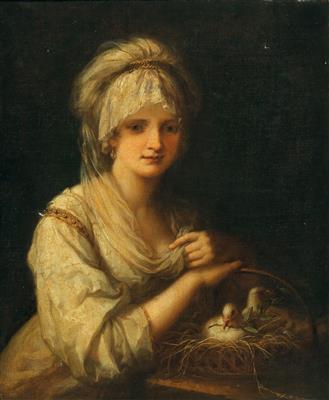Angelika Kauffmann

(Chur 1741–1807 Rome)
Allegory of Conjugal Peace,
oil on canvas, 75 x 63.5 cm, framed
Provenance:
Private collection, Great Britain (19th Century);
Collection of Alfred Straßer (1895–1967), the composer, Vienna;
Collection of Baron Goldschmidt-Rothschild, Brasil;
Noble collection, Vienna
Exhibited:
possibly London, Royal Academy, 1779, no. 166;
Vienna, Secession, XXXVIIth Exhibition of the Vereinigung Bildender Künstler Österreichs, 1910, no. 5
We are grateful to Bettina Baumgärtel for confirming the attribution after examination of the present painting in the original and for her help in cataloguing.
The present painting has been reproduced in prints by Thomas Burke (1748–1815), Conjugal Peace, stipple technique in red chalk, published the 3 May 1779 by W.W. Ryland, London (see also The British Museum collection, no. 1873,0809.269).
Baumgärtel wrote: ‘The allegory of Conjugal Peace is personified by a female half-length figure in an antique white garment, her right arm supported on a basket that has been placed on a monumental stone pedestal. The basket serves as a straw nest for two pigeons sitting peacefully next to each other. The woman’s headscarf, bound by a golden band at the crown of her head, falls down on one side as a veil, and she holds it with her left hand to cover her breast in a gesture of chastity. Both this very gesture, an allusion to Raphael’s famous Donna Velata, and the headdress, which seem unusual for today’s standards, represent attributes of conjugal chastity. In combination with the headscarf, the pigeons refer to those female virtues that were regarded as absolute prerequisites for a peaceful marriage: chastity, simplicity, and virtuousness. Contemporary viewers were perfectly able to interpret these signs, all the more so as it was considered unbecoming for a married woman until well into the eighteenth century to present herself in public with her head uncovered […]. Kauffmann painted several slightly differing versions of this composition. One of them, which is not identical to the present painting, was still on loan from Marion Davies to the Los Angeles County Museum until several years ago and in 1995 entered the art market. According to the current state of research, the painting exhibited in Vienna in 1910, on the other hand, appears to be identical with the present version, provided that the mezzotint published in Kunst für alle in 1911 was based on the oil painting in the collection of Alfred Straßer.’
Esperto: Dr. Alexander Strasoldo
 Dr. Alexander Strasoldo
Dr. Alexander Strasoldo
+43 1 515 60 403
oldmasters@dorotheum.com
30.04.2019 - 17:00
- Prezzo realizzato: **
-
EUR 149.700,-
- Stima:
-
EUR 40.000,- a EUR 60.000,-
Angelika Kauffmann
(Chur 1741–1807 Rome)
Allegory of Conjugal Peace,
oil on canvas, 75 x 63.5 cm, framed
Provenance:
Private collection, Great Britain (19th Century);
Collection of Alfred Straßer (1895–1967), the composer, Vienna;
Collection of Baron Goldschmidt-Rothschild, Brasil;
Noble collection, Vienna
Exhibited:
possibly London, Royal Academy, 1779, no. 166;
Vienna, Secession, XXXVIIth Exhibition of the Vereinigung Bildender Künstler Österreichs, 1910, no. 5
We are grateful to Bettina Baumgärtel for confirming the attribution after examination of the present painting in the original and for her help in cataloguing.
The present painting has been reproduced in prints by Thomas Burke (1748–1815), Conjugal Peace, stipple technique in red chalk, published the 3 May 1779 by W.W. Ryland, London (see also The British Museum collection, no. 1873,0809.269).
Baumgärtel wrote: ‘The allegory of Conjugal Peace is personified by a female half-length figure in an antique white garment, her right arm supported on a basket that has been placed on a monumental stone pedestal. The basket serves as a straw nest for two pigeons sitting peacefully next to each other. The woman’s headscarf, bound by a golden band at the crown of her head, falls down on one side as a veil, and she holds it with her left hand to cover her breast in a gesture of chastity. Both this very gesture, an allusion to Raphael’s famous Donna Velata, and the headdress, which seem unusual for today’s standards, represent attributes of conjugal chastity. In combination with the headscarf, the pigeons refer to those female virtues that were regarded as absolute prerequisites for a peaceful marriage: chastity, simplicity, and virtuousness. Contemporary viewers were perfectly able to interpret these signs, all the more so as it was considered unbecoming for a married woman until well into the eighteenth century to present herself in public with her head uncovered […]. Kauffmann painted several slightly differing versions of this composition. One of them, which is not identical to the present painting, was still on loan from Marion Davies to the Los Angeles County Museum until several years ago and in 1995 entered the art market. According to the current state of research, the painting exhibited in Vienna in 1910, on the other hand, appears to be identical with the present version, provided that the mezzotint published in Kunst für alle in 1911 was based on the oil painting in the collection of Alfred Straßer.’
Esperto: Dr. Alexander Strasoldo
 Dr. Alexander Strasoldo
Dr. Alexander Strasoldo
+43 1 515 60 403
oldmasters@dorotheum.com
|
Hotline dell'acquirente
lun-ven: 10.00 - 17.00
old.masters@dorotheum.at +43 1 515 60 403 |
| Asta: | Dipinti antichi |
| Tipo d'asta: | Asta in sala |
| Data: | 30.04.2019 - 17:00 |
| Luogo dell'asta: | Wien | Palais Dorotheum |
| Esposizione: | 20.04. - 30.04.2019 |
** Prezzo d'acquisto comprensivo di tassa di vendita e IVA
Non è più possibile effettuare un ordine di acquisto su Internet. L'asta è in preparazione o è già stata eseguita.
